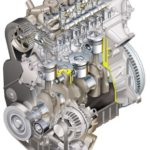Karl Benz
Karl Benz was born on November 25, 1844 as Karl Friedrich Michael Vaillant in the town of Milburb, now Karlsruhe, in the German state of Baden. His mother Josefine Wylant and father Johan Benc were married a year after his birth. When Karl was 2 years old, his father, a locomotive driver, died in a train accident, after which the toddler was changed to Karl Friedrich Benz.
Education

The 1893 Benz Victoria was for sale at 3875 gold marks
Although left with a child in poverty, Jozefina is making efforts to get her son a good education, and since the age of 9, the boy has been attending science education institutions. At the Polytechnic College he first chooses a locksmith direction, but later, following his father's steps, directs the construction of the locomotive. At only 15 years of age, in 1860, Karl Benz took the entrance examination at the Polytechnic University. Less than 4 years later, Benc graduates with a mechanical engineering degree.
Mision

A man with a vision and his work - a patent motorized three-wheeler
An anecdote from his student days tells him that during the daily rides of a cheap bicycle, he began to think of a kind of suitable vehicle that would move without muscle strength, a "horse-free carriage." He also says he promised himself that he would one day make it.
Despite seven years of professional training at many companies in Germany and Austria, Benz has not stopped dreaming of this achievement. He needed money and working conditions for something like that, and he was determined to make it happen. He therefore quit the job of drawing and designing, and in 1871, with August Ritter in Mannheim, set up a machine shop for the supply of metal materials. Unfortunately, the first year of operation is a fiasco for the company. Local authorities are monopolizing the business, and Ritter is proving to be an unreliable partner. Bertha Ringer, Ben's fiancée, then enters the scene and redeems Ritter's piece with her dowry.
First steps

A Benz convoy in 1895 around Mannheim with Karl's daughters at the helm
In spite of all the difficulties, Karl Benz did not give up in order to make a new age vehicle. His resolve has only been gaining strength for years. As the biggest problem lay in developing the right engine, Benc found hope in the SUS engine, which was in the early stages of increasing reliability and efficiency. In 1878, he focused on the business of making a two-stroke gas engine, based on the Otto concept, which was patented two years earlier. The engine was operational until New Year's Eve, with the patent in Benc's hands during 1879.
Although he essentially worked on the production standard of two-stroke engines, his ingenious creativity was expressed primarily through the development of additional components. So he got patents for the engine speed regulator, spark ignition system with battery, spark plug, carburetor… However, Benz did not stay there. When he had an engine, the door to make a self-propelled vehicle was open. The following are patents for gearbox, main clutch, coolant cooler (
Gasman Fabrik Mannheim
When things seemed to be going in the right direction, the troubles got Ben diligent again. Due to the high production costs of gas engines, the banks that monitored the company's operations required a recapitalization, which directly meant the company becoming a corporation. Thus, various investors come into possession of the firm's shares, and Mannheim banks are stepping up their stake. The result was the founding of a joint-stock company under the name Gasmotoren Fabrik Mannheim in 1882.
Benz, 38, could not have been pleased with this kind of forced process. He has only 5% left in his hands and a modest CEO salary. The worst thing, though, was the fact that his ideas were not considered when trying to launch new products, so his departure from the corporation was only a matter of time. Heavy-hearted gas is leaving the company he founded and raised, just one year after the changes.
Benz & Co.

"Benz's patented motor vehicle" - Mercedes-Benz Museum in Stuttgart
Quite by accident, as life knows how to stage it, Benz starts a fateful conversation with the owners Max Rose and Friedrich Wilhelm Eßlinger in a Mannheim bicycle spare parts store. The conversation of lovers of technology resulted in the pooling of their capital, possibilities and knowledge, and in 1883 they started a machine production plant. The company is named Benz & Co. Rheinische Gasmotoren-Fabrik (Benz & CO. Rhine Gas Engine Factory), and initially employs 25 workers. Very quickly, this company also sells its licenses for the production of gas engines, which shows that Benz continued to create.
In a creative environment that he has recreated for himself, Benz returns to his obsession, the construction of "horse-free carriages." This business shows the impact of his love for bicycles, as well as the people with whom he founded the company. He replaces the rear wheel of the bike with two, and mounts the engine between them. The engine was specially prepared for the reduced Otto four-stroke gas engine, and its power to the rear axle was carried out by means of a chain transmission. In 1885, in this way, Benc made his first Tricolor, in his 42nd year. Unlike Daimler, who built his engine into the carriages, rounded out the entirety of the vehicle, Benz is justifiably considered the creator of the car.
The driving test

The first commercial for a motor vehicle appeared in 1886
After childbirth, a motorized tricycle awaited the ordeal of childhood diseases. The first tests often attracted observers from the neighborhood, and all activities were exposed to numerous views. As the Trolley was quite difficult, there were often comical bumps into the wall to which the crowd responded with a burst of laughter and derision. For this reason, the whole project fell under the shadow of a bad reputation, until the daring Berta Benz took matters back into her own hands. Bravely getting into the three-wheeled vehicle, she drove through the city streets to the startled townspeople. Because of this ride, Berta is now considered the first person to ever drive a car in history.
The three-wheeler was finally granted patent protection on January 29, 1886 under the number DRP-37435 and entitled "Gas Powered Car". In the middle of the same year, Benz switches from gas to gasoline engine, created by Daimler and Maybach (patented in 1885), and goes into the first car sales ever. The advertising name chosen for the occasion read: "Benc's patented motor vehicle".
By Predrag Djukic
Source: www.b92.net
Recommendation of similar texts:

Hi there, I am Mladen and I am an auto enthusiast. I started this blog years ago to help like minded people share information about latest cars, car servicing ideas, used car info, exotic cars, and auto technology. You will find helpful articles and videos on a wide variety of cars - Audi, Mercedes, Toyota, Porsche, Volvo, BMW and much more. Ping us if you have anything cool to share on latest cars or on how to make older cars more efficient, or just want to say hi!







